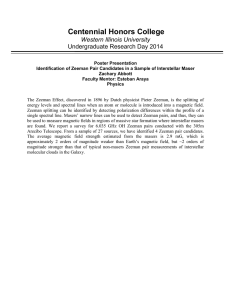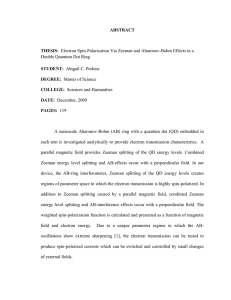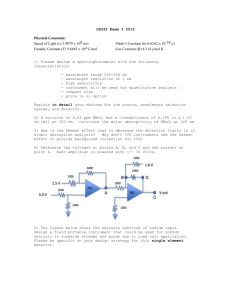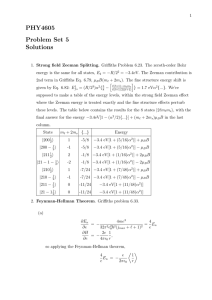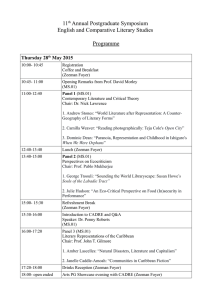VERY LARGE ARRAY DETECTION OF THE 36 GHz Please share
advertisement
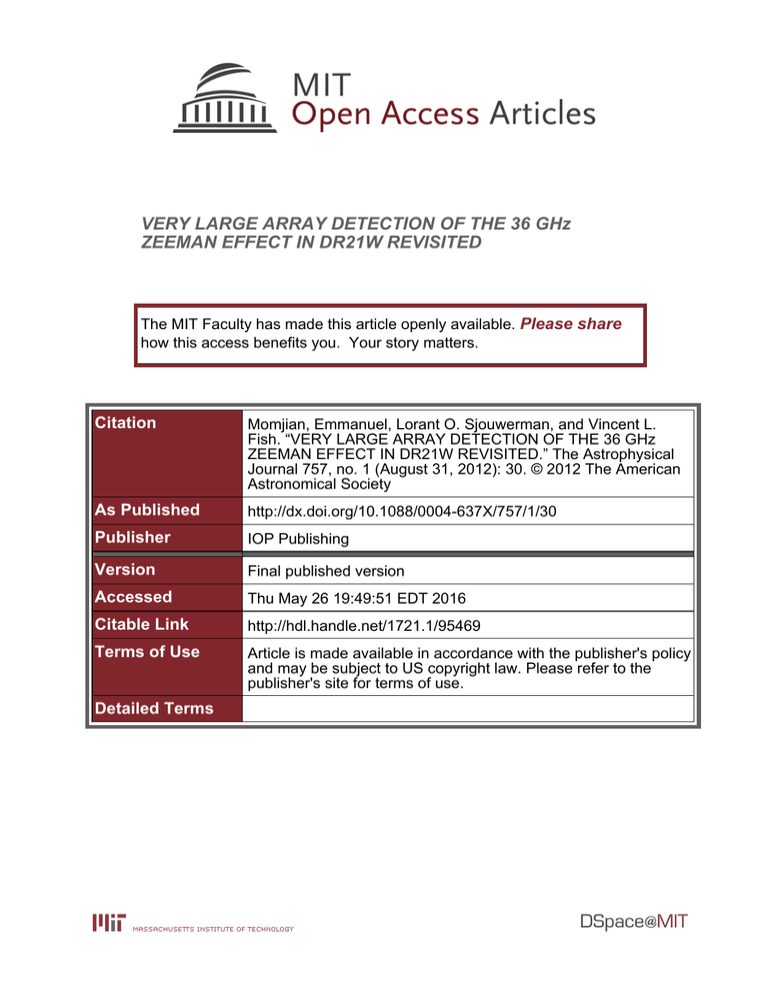
VERY LARGE ARRAY DETECTION OF THE 36 GHz ZEEMAN EFFECT IN DR21W REVISITED The MIT Faculty has made this article openly available. Please share how this access benefits you. Your story matters. Citation Momjian, Emmanuel, Lorant O. Sjouwerman, and Vincent L. Fish. “VERY LARGE ARRAY DETECTION OF THE 36 GHz ZEEMAN EFFECT IN DR21W REVISITED.” The Astrophysical Journal 757, no. 1 (August 31, 2012): 30. © 2012 The American Astronomical Society As Published http://dx.doi.org/10.1088/0004-637X/757/1/30 Publisher IOP Publishing Version Final published version Accessed Thu May 26 19:49:51 EDT 2016 Citable Link http://hdl.handle.net/1721.1/95469 Terms of Use Article is made available in accordance with the publisher's policy and may be subject to US copyright law. Please refer to the publisher's site for terms of use. Detailed Terms The Astrophysical Journal, 757:30 (2pp), 2012 September 20 C 2012. doi:10.1088/0004-637X/757/1/30 The American Astronomical Society. All rights reserved. Printed in the U.S.A. VERY LARGE ARRAY DETECTION OF THE 36 GHz ZEEMAN EFFECT IN DR21W REVISITED 1 Emmanuel Momjian1 , Loránt O. Sjouwerman1 , and Vincent L. Fish2 National Radio Astronomy Observatory, P.O. Box O, 1003 Lopezville Road, Socorro, NM 87801, USA; emomjian@nrao.edu 2 MIT Haystack Observatory, Route 40, Westford, MA 01886, USA Received 2012 June 15; accepted 2012 July 23; published 2012 August 31 ABSTRACT We report on the observation of the 36 GHz methanol maser line in the star-forming region DR21W to accurately measure the Zeeman effect. The Zeeman signature reported by Fish et al. became suspicious after an instrumental effect was discovered in the early days of the commissioning of the Very Large Array Wide-band Digital Architecture correlator. We conclude that the previously reported magnetic field strength of 58 mG (1.7 Hz mG−1 /z) is instrumental in nature and thus incorrect. With the improved performance of the array, we now deduce a 3σ limit of −4.7 to +0.4 mG (1.7 Hz mG−1 /z) for the line-of-sight component of the magnetic field strength in DR21W. Key words: ISM: molecules – magnetic fields – masers – radio lines: ISM – stars: formation Online-only material: color figure observing strong spectral lines at high frequency resolutions. Zeeman effect studies, which in this case rely on the difference of two strong signals, were particularly vulnerable. This rendered the so-called S-curve profiles in the Stokes V spectra very unreliable (Sault 2010, 2012a, 2012b). Since then, and up until the problem was fully understood, all Zeeman effect observations with the VLA were put on hold. Zeeman effect commissioning tests were concluded in 2012 March, and in 2012 April these observations were officially reintroduced.3 Here, we report on the reobservation of the Zeeman effect in DR21W with the WIDAR correlator and comment on the previously reported, uncomfortably high value of the magnetic field strength as deduced in the 36 GHz line by Fish et al. (2011). 1. INTRODUCTION Studies of the Class I methanol masers found in shock-excited environments, e.g., in star-forming regions in the Galaxy, have recently received a boost in interest. This interest is due to the increased frequency coverage of radio interferometers, allowing for higher angular resolution observations of the low-level excited lines, e.g., lines at 25, 36, and 44 GHz (e.g., Voronkov et al. 2005, 2006; Sjouwerman et al. 2010). The brightness of a few of these masers allows the measurement of the Zeeman effect and thus the determination of the magnetic field of the environment in which they occur. As a result of the large uncertainty in the Zeeman splitting factor for methanol (Vlemmings et al. 2011), magnetic field strengths are commonly reported in units of the (unknown) splitting coefficient (i.e., with z = 1.7 Hz mG−1 for the 36 GHz transition). Despite this uncertainty, significant results can be deduced for magnetic fields in units of the actual value, i.e., in terms of 1.7 Hz mG−1 /z for the 36 GHz transition. Examples of Zeeman splitting studies in Class I methanol masers are Sarma & Momjian (2009, 2011), Fish et al. (2011), and Momjian & Sarma (2012). In 2010, the commissioning of the new, Wide-band Digital Architecture (WIDAR) correlator of the Karl G. Jansky Very Large Array (VLA) had started (Perley et al. 2011). During commissioning, the VLA continued to obtain scientific observations with this new correlator. Together with, e.g., the new 26.5–40 GHz Ka-band receivers, it demonstrated the excellent performance of the VLA with the detection of many new 36 GHz Class I methanol masers (e.g., Sjouwerman et al. 2010). As a result, a Zeeman-like signature was observed at 36 GHz in DR21W (Fish et al. 2011), which ostensibly implied a line-of-sight magnetic field strength of B cos θ = 58 mG (1.7 Hz mG−1 /z). This value is much larger than expected at methanol maser sites in star-forming regions. Indeed, the authors did caution against interpreting the Stokes V signature as a very strong magnetic field, but the detection looked convincing enough to warrant further discussion in their paper. However, soon after the first publication (Fish et al. 2011), the WIDAR commissioning team discovered a small but significant unanticipated spectral response, or “spectral splatter” effect, while 2. OBSERVATIONS AND DATA REDUCTION Observations of the 4−1 − 30 E methanol maser emission line at 36.169 GHz toward the star-forming region DR21W were carried out with the VLA on 2012 May 1 in two 2 hr observing sessions. The array was in CnB configuration, providing a synthesized beam of 0. 51 × 0. 40. The observations were performed in dual polarization with 2 MHz bandwidth using 256 spectral channels, resulting in a channel separation of 7.8 kHz, or a velocity separation of 65 m s−1 . The total on-source time was 170 minutes after combining both observing runs. The calibrator sources 3C286 and 3C84 were used to set the absolute flux density scale. The editing, calibration, deconvolution, and imaging of the data were carried out using NRAO’s Astronomical Image Processing System (Greisen 2003). After applying the amplitude gain corrections of the calibrators 3C286 and 3C48 on the target source DR21W, the data were Doppler corrected and the spectral channel with the brightest maser emission signal was split off. This single-channel signal was self-calibrated in both phase and amplitude and imaged in a succession of iterative cycles. The final phase and amplitude solutions were then applied to the full spectral-line visibility data of the target source, and Stokes I = (RCP + LCP)/2 and V = (RCP − LCP)/2 image cubes were 3 Commissioning tests show that observations since 2011 August could be used for spectral-line polarization measurements. 1 The Astrophysical Journal, 757:30 (2pp), 2012 September 20 Momjian, Sjouwerman, & Fish the Stokes V spectrum. We note that the Zeeman splitting coefficient (z) of the 36 GHz methanol maser transition is currently unknown (Vlemmings et al. 2011), but for proper comparison with the results of Fish et al. (2011), and Sarma & Momjian (2009), we are quoting the values with respect to 1.7 Hz mG−1 /z, where 1.7 Hz mG−1 was tentatively assumed as the Zeeman splitting coefficient for this maser transition. Performing a one-dimensional χ 2 fit for V, we obtain a 3σ range of −4.7 to +0.4 mG (1.7 Hz mG−1 /z), depending whether the line-of-sight component (B cos θ ) of the field is oriented toward (−) or away (+) from the observer. These values are shown in the dashed (+3σ ) and solid (−3σ ) thin blue curves in Figure 1. The results obtained from these observations show that the Zeeman effect signature in the 36 GHz methanol maser line reported by Fish et al. (2011) is not correct. Because our observations were carried out in two observing runs, we have been able to verify that our resulting non-detection of the Zeeman splitting in the strongest 36 GHz maser in DR21W holds for both sessions separately. We exclaim our appreciation of the concerted effort performed by the VLA WIDAR commissioning team to resolve the issues that led to the contamination and corruption of Zeeman effect observations at the VLA. The National Radio Astronomy Observatory (NRAO) is a facility of the National Science Foundation operated under cooperative agreement by Associated Universities, Inc. Facility: VLA Figure 1. For a putative S-curve Zeeman effect, the thick red curve shows the best-fit value of −2.1 mG (1.7 Hz mG−1 /z) to the Stokes V spectrum. The fit shows that there is no significant S-curve Zeeman effect in the data, unlike the (instrumental) result in Figure 3 of Fish et al. (2011). The thin dashed and solid blue curves show the extent of the 3σ range of a possible magnetic field of up to −4.7 and +0.4 mG (1.7 Hz mG−1 /z), respectively. (A color version of this figure is available in the online journal.) constructed. Further processing of the data was done using the MIRIAD data reduction package to remove the scaled replica of the Stokes I spectrum from the observed Stokes V spectrum through least-squares fitting using the equation: Vobs = aI + REFERENCES Fish, V. L., Muehlbrad, T. C., Pratap, P., et al. 2011, ApJ, 729, 14 Greisen, E. W. 2003, in Information Handling in Astronomy - Historical Vistas, ed. A. Heck (Astrophysics and Space Science Library, Vol. 285; Dordrecht: Kluwer), 109 Momjian, E., & Sarma, A. P. 2012, AJ, submitted Perley, R. A., Chandler, C. J., Butler, B. J., & Wrobel, J. M. 2011, ApJ, 739, L1 Sarma, A. P., & Momjian, E. 2009, ApJ, 705, L176 Sarma, A. P., & Momjian, E. 2011, ApJ, 730, 5 Sault, R. J. 2010, EVLA Memo 148 (http://www.aoc.nrao.edu/evla/ memolist.shtml) Sault, R. J. 2012a, EVLA Memo 157 (http://www.aoc.nrao.edu/evla/ memolist.shtml) Sault, R. J. 2012b, EVLA Memo 160 (http://www.aoc.nrao.edu/evla/ memolist.shtml) Sjouwerman, L. O., Pihlström, Y. M., & Fish, V. L. 2010, ApJ, 710, L111 Vlemmings, W. H. T., Torres, R. M., & Dodson, R. 2011, A&A, 529, 95 Voronkov, M. A., Brooks, K. J., Sobolev, A. M., et al. 2006, MNRAS, 373, 411 Voronkov, M. A., Sobolev, A. M., Ellingsen, S. P., & Ostrovskii, A. B. 2005, MNRAS, 362, 995 zB cos θ dI . 2 dν The fit parameter a is usually the result of small calibration errors in RCP versus LCP and is expected to be small. In these observations, a is of order 10−3 . 3. RESULTS AND DISCUSSION Figure 1 shows the Stokes I and Stokes V spectra toward the strongest 36 GHz methanol maser in DR21W—the same maser as in Figure 3 in Fish et al. (2011). Here, the thick red curve shows the best-fit value of −2.1 mG (1.7 Hz mG−1 /z) to a putative S-curve Zeeman signature in the Stokes V spectrum. This best fit is insignificant as it is well within the noise of 2
